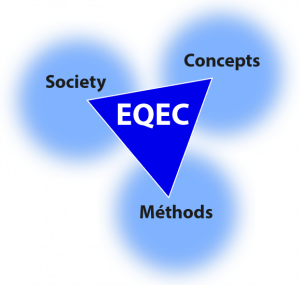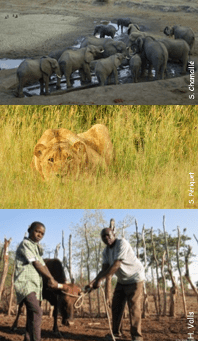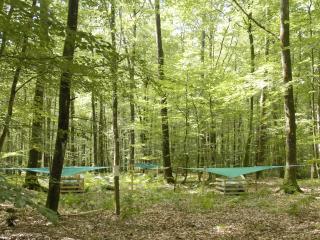Quantitative and Evolutionary Ecology of Communities Group
Members

Doctorante
UCBL

Professeure des universités
VetAgro-Sup
Tel: 33 04 72 43 27 56

Directeur de recherche
CNRS
Tel: 33 04 72 43 27 57

Doctorant
UCBL
Tel: 04 72 44 81 42

Doctorant
CNRS
Tel: 04 72 44 81 42
Doctorant
VetAgro-Sup

Maître de conférences
UCBL
Tel: 04 72 44 81 42
Doctorant
UCBL


Professeur des universités
UCBL
Tel: 33 04 72 43 27 56

Professeur des universités
UCBL

Directeur de recherche
CNRS
Tel: 33 04 72 43 27 56

Maîtresse de conférences
UCBL
Tel: 33 04 72 43 29 02
Maître de conférences
UCBL
Tel: 33 04 72 43 29 02

Our research activities, focused on interspecific interactions (community ecology), aim to better understand the ecological and evolutionary processes structuring species assemblages and biodiversity at different temporal and spatial scales. Our team addresses these major issues using contrasting biological models (communities of large African mammals, insects, microbiota, plants) from 3 complementary angles:
- Our work is strongly anchored in the conceptual framework of evolutionary biology by studying (i) the diversity of adaptive responses implemented by organisms to selective pressures in their environment, (ii) their consequences on population demography and ultimately (iii) the dynamics and composition of species communities.
- Our research is closely linked to societal issues of biodiversity conservation and management by integrating both the functioning of socio-ecological systems and the context of climate change. We conduct experimental studies, manage and ensure the long-term monitoring of several community observation networks.
- Methodological issues also occupy a central place in our team, with the development of new tools for statistical processing and modeling of ecological data. This activity leads to the development of methods and software that we develop and distribute freely.
Research programs

Functioning of African savanna communities
The Hwange LTSER (Long-Term Socio-Ecological Research site in Zimbabwe hosts a long-term interdisciplinary research program that focuses on the functioning of plant and animal communities within the Hwange National Park and the interactions between this protected area and humans living in its periphery. Based on this program, three axes are developed: (1) studying the population dynamics of elephants, exploring their impact and that of management policies on the socio-ecosystem functioning; (2) Understanding the extent to which interactions within and between trophic levels are sensitive to management actions (e.g. sport hunting, water management) and climate change; (3) Decoding human ecology and human-wildlife coexistence mechanisms towards integrated conservation and sustainable functioning of the socio-ecosystem. This research is complemented by more recent works in the Hluhluwe-iMfolozi Park and in the Madikwe reserve in South Africa, which focus on the role of environmental conditions on the hunting success of large African carnivores. We work in close collaboration with the IRL (International Research Lab) Rehabs.
Involved group members : Alice Bernard, Laura Lacomme, Aïssa Morin, Lisa Nicvert, Elie Pedarros, Yolan Richard, Marion Valeix*

Masting and the community dynamics of seed consumers
Masting is a reproductive strategy often encountered in perennial plants, characterized by fructifications highly fluctuating in time and being synchronized at the population level. The seeds produced that way constitute a pulsed resource with a strong impact on the eco-evolutionary dynamics of seed-consuming communities and forest regeneration. Our lack of knowledge of this system still impedes our understanding of the dynamics of temperate forest ecosystems and its future in the context of climate change. Our work carried out on oak forests aims to better understand (i) the proximal causes of masting, (ii) the mechanisms underlying the coexistence of species competing for such highly fluctuating resource and (iii) the co-evolution of consumer exploitation strategies for the fluctuating resource and forest tree fruiting strategies. On the basis of the results obtained, scenarii will be proposed on the future of forest regeneration under climate change, that may serve forest management.
Involved group members : Marie-Claude Bel-Venner*, Emilie Fleurot, Léa Keurinck, Jean Lobry, Samuel Venner

The spread of antibiotic resistance genes in bacteria
Antibiotic resistance is recognized as one of the greatest current threats to human health, and the mobile genetic elements (MGEs) that circulate in bacterial populations and communities are the main vehicles. To understand the dynamics and diversity of MGEs in bacterial pangenomes and the emergence of antibiotic resistance genes, we propose to go beyond the framework of conventional genomics by considering pangenomes as complex ecological communities. In the Ab-One program, we mobilize the concepts and tools developed in community ecology based on an integrative approach (monitoring of bacterial populations/communities evolving in contrasting environments -One-Health approaches-, pan-genomic analyses, experimentation in molecular and cellular microbiology, mathematical modelling). This program is currently focused on the dynamics of MGEs in Acinetobacter baumannii, an antibiotic-resistant microorganism classified as a priority by the WHO. Other more general approaches will illustrate the relevance of this new conceptual framework to understand the dynamics and diversity of MGEs in bacterial pangenomes. This program, co-piloted by our team and a team from CIRI (Horigene) involves the participation of 9 organizations (6 from Lyon -LBBE, CIRI, MMSB, HCL, LEM, VetAgro Sup-, Institut Pasteur (Paris), LMGM (Toulouse ), Robert Koch Institute (Germany)).
Involved group members : Stéphane Dray, Rémi Tuffet, Samuel Venner*

Statistical analysis of ecological data
Understanding the structure and dynamics of species assemblages, and the processes behind them, requires collecting data that are becoming increasingly complex owing to the sophisticated technological developments made available for their acquisition (e.g. GPS, loggers, satellite imagery, molecular data). We are developing new methods for analysing such data, that provide new insights into the ecological processes at work in communities. Multivariate analysis methods allow the analysis of spatial structures, accounting for various information on species (functional traits, morphology, phylogeny), the spatio-temporal variation of species-environment relationships or the multifaceted perception of the protected human-environment relationship. We also model multi-'omics' dose-response data within communities in order to better understand the Adverse Outcome Pathway (AOP) and to better appreciate the risks to the environment. These methodological innovations are made available to the scientific community through the development, distribution and maintenance of software (libraries for the R language: ade4, adegraphics, adephylo, ade4TkGUI, nlstools, fitdistrplus, DRomics, seqinr).
Involved group members: Marie Laure Delignette-Muller, Stéphane Dray*, Jean Lobry, Jean Thioulouse.
Publications
Display of 211 to 240 publications on 656 in total
How to implement functional responses of migroalgae in risk assessment processing ?
Congrès européen de la SETAC «Science and Technology for Environmental Protection» .
Conference paper
see the publicationDefining simple toxicity values (EC, BMD) is not so simple
Congrès européen de la SETAC «Science and Technology for Environmental Protection» .
Poster
see the publicationMultiple facets of rarity among rain forest trees in the Western Ghats of India
Biological Conservation . 228 : 110-119
Journal article
see the publicationTaxonomic and ecological database of trees of Western Ghats - TreeGhatsData
Preprint
see the publicationHow teachers' attitudes on GMO relate to their environmental values
Journal of Environmental Psychology . 57 : 1-9
Journal article
see the publicationSpecies distribution modeling based on the automated identification of citizen observations
Applications in Plant Sciences . 6 ( 2 ) : 1-11
DOI: 10.1002/aps3.1029
Journal article
see the publicationCushion-plant protection determines guild-dependent plant strategies in high-elevation peatlands of the Cordillera Real, Bolivian Andes
Perspectives in Plant Ecology, Evolution and Systematics . 30 : 103-114
Journal article
see the publicationImpact of currently marketed tampons and menstrual cups on Staphylococcus aureus growth and TSST-1 production in vitro
Applied and Environmental Microbiology . 84 ( 12 )
DOI: 10.1128/AEM.00351-18
Journal article
see the publicationPlant Strategies along Resource Gradients
The American Naturalist . 192 ( 3 ) : 360 - 378
DOI: 10.1086/698600
Journal article
see the publicationFacilitation- versus competition-driven succession: the key role of resource-ratio
Ecology Letters . 21 ( 7 ) : 1010-1021
DOI: 10.1111/ele.12966
Journal article
see the publicationThe ground plot counting method: A valid and reliable assessment tool for quantifying seed production in temperate oak forests?
Forest Ecology and Management . 430 : 143-149
Journal article
see the publicationThe ground plot counting method: A valid and reliable assessment tool for quantifying seed production in temperate oak forests?
Forest Ecology and Management . 430 : 143-149
Journal article
see the publicationEvaluation de méthodes diagnostiques en l’absence de gold standard sur la base de variables binaires et continues : intérêt de l'approche bayésienne
Journée AppliBUGS . : 38 slides
Conference paper
see the publicationDiagnosis of bovine dictyocaulosis by bronchoalveolar lavage technique: A comparative study using a Bayesian approach
Preventive Veterinary Medicine . 154 : 124-131
Journal article
see the publicationDisentangling good from bad practices in the selection of spatial or phylogenetic eigenvectors
Ecography . 41 ( 10 ) : 1638-1649
DOI: 10.1111/ecog.03380
Journal article
see the publicationOptimizing the choice of a spatial weighting matrix in eigenvector-based methods
Ecology . 99 ( 10 ) : 2159-2166
DOI: 10.1002/ecy.2469
Journal article
see the publicationSimple parametric tests for trait–environment association
Journal of Vegetation Science . 29 ( 5 ) : 801-811
DOI: 10.1111/jvs.12666
Journal article
see the publicationSupervised Multiblock Analysis in R with the ade4 Package
Journal of Statistical Software . 86 ( 1 )
Journal article
see the publicationMOSAIC: a web-interface for statistical analyses in ecotoxicology
Environmental Science and Pollution Research . 25 ( 12 ) : 11295-11302
Journal article
see the publicationDRomics: A Turnkey Tool to Support the Use of the Dose–Response Framework for Omics Data in Ecological Risk Assessment
Environmental Science and Technology . 52 ( 24 ) : 14461-14468
Journal article
see the publicationAssessment of Ozone or Not-Treated Wastewater Ecotoxicity Using Mechanism-Based and Zebrafish Embryo Bioassays
Journal of Environmental Protection . 09 ( 04 ) : 325 - 346
Journal article
see the publicationIntegrating spatial and phylogenetic information in the fourth‐corner analysis to test trait–environment relationships
Ecology . 99 ( 12 ) : 2667-2674
DOI: 10.1002/ecy.2530
Journal article
see the publicationComplex ecological interactions of Staphylococcus aureus in tampons during menstruation
Scientific Reports . 8 ( 1 ) : 9942
Journal article
see the publicationBeyond neutrality: disentangling the effects of species sorting and spurious correlations in community analysis
Ecology . 99 ( 8 ) : 1737-1747
DOI: 10.1002/ecy.2376
Journal article
see the publicationAlgorithms and biplots for double constrained correspondence analysis
Environmental and Ecological Statistics . 25 ( 2 ) : 171-197
Journal article
see the publicationDatabase Of Weeds In Cultivation Fields Of France And Uk, With Ecological And Biogeographical Information
Other publication
see the publicationCaractère fonctionnelle des plantes adventices : comparaison avec les espèces prairiales
Journée "Approche fonctionnelle pour la gestion des espèces adventices et de la flore des linéaires non cultivés » .
Conference paper
see the publicationA Common Toolbox to Understand, Monitor or Manage Rarity? A Response to Carmona et al.
Trends in Ecology & Evolution . 32 ( 12 ) : 891-893
Journal article
see the publicationWhat makes a weed a weed ? Towards a functional characterization
"Functional Ecology and Environment" Conference .
Conference paper
see the publication
You also, comment on this article